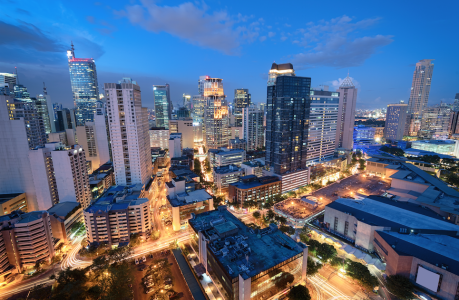
Boomtowns in Southeast Asia
Boomtowns in Southeast Asia
Share
This article originally appeared in AR146 – available now through newsstands and digitally through Zinio.
PHILIPPINES
With the second-fastest growing GDP (gross domestic product) behind China, the Philippines is going through an intense stage of growth. There is currently a lot of investment in infrastructure, and the building spree is not just limited to traditional metropolitan areas like Makati and Taguig.
The Philippines is continuing to capture wider attention. It is not just Metro Manila – the country’s political and economic powerhouse – that is enticing. And other markets such as Cebu, Boracay and Davao on the island of Mindanao are also healthy, despite projections of slower economic growth last year.
Commercial real estate is especially strong, with businesses renting out retail and commercial spaces in Quezon City, Pasay and the bay area of Manila.
Premium office spaces are seeing record sales, and property values are sharply rising by the year. For example, Ayala Land’s first office project in Bonifacio Global City in Taguig sold 95 percent of its units in the first tower just a year after its launch. And 93 percent of the second tower within the same time period.
Office space is being rented by multinational companies, mainly from the business process of outsourcing and manufacturing industries. Companies from these industries tend to lease office spaces for an average of five years, much longer than residential spaces, and this trend is promising for property developers as they receive recurring income over a longer period.
In the Visayas, Bacolod and Iloilo are catching up to Cebu. Cagayan de Oro and Zamboanga, meanwhile, are up-and-coming areas of Mindanao, after Davao.
The city of Iloilo is significant to note. Located on Panay Island, it has seen a boom in recent years and is considered one of the most progressive in the country in urban redevelopment. Infrastructural and architectural projects include the Iloilo Esplanade, a convention centre and mixed-used development in the rejuvenated old airport area. Good road infrastructure also links suburban residential projects. While architectural rejuvenation has been progressive, the city of Iliolo has kept many of its Heritage buildings and some have been adapted for reuse.
The Philippines’ new President Rodrigo Duterte should also speed up the spread of modernisation and rejuvenation as the President’s winning campaign was built on a platform of decentralisation of CBDs and pushing for the development of provinces in hopes of decongesting major city areas.
According to the Philippines’ national statistics authority, real estate and construction make up a combined share of 18.1 percent of real GDP. It should be noted that the positive outlook is tempered with longstanding issues that have plagued the sprawling island nation, such as swathes of ageing infrastructure and lack of transparency. There have been talks by the government, however, about improving infrastructure through public-private partnerships. These partnerships will be tremendously beneficial for future real estate developments should there be a successful follow-through.
With property markets flourishing in the 7500-plus islands in the Philippines, now is a good time to explore the opportunities on offer.
VIETNAM
With an economy buoyed by a burgeoning middle class, and encouraged by an easing of real estate laws, the property sector is emerging from a market collapse not too long ago, and looks set for a boom again.
DKO Architecture is just one Australian practice optimistic about the region. The firm recently opened a new office in Ho Chi Minh City to manage a ‘multitude of significant new commissions’, in both the Vietnamese capital and Hanoi. While it has bases in Melbourne, Sydney, Christchurch and Auckland, this is the practice’s first office in Asia.
Vietnam still has some ground to make up, however. The collapse of 2011, which left US$6 billion worth of unsold properties and banks crippled by defaults, has led to the State Bank of Vietnam (SBV) tightening criteria on domestic home loans.
Experts say a healthier economy in the US, where many of the diaspora live, and Vietnam’s improving business prospects are encouraging people to send money back to Vietnam where extended families still reside.
The SBV expects remittances to hit a record US$14 billion this year, and to be equivalent to 6.4 percent of GDP. The growth in remittance is also expected to eclipse that of the Philippines, Southeast Asia’s top remittance receiver as a share of GDP, and these cash inflows are fuelling an economy that grew 6.7 percent last year – a pace not seen since 2008. Property prices are also being supported with a fifth of cash remitted going into real estate, according to the SBV.
New legislation easing restrictions on ownership by foreign citizens have made it easier for Japanese, South Korean, Singaporean and overseas Vietnamese investors who are keen to buy in Vietnam.
Underlying demand will, however, come from Asia’s fastest rates of middle-class expansion. Research agency JLL rates Ho Chi Minh City as the fastest improving among the 120 cities in its Momentum Index in 2015. This year, the report highlighted Hanoi and Ho Chi Minh City as Asia’s growth hotspots. The research agency said that the two cities have prominent economic momentum, propelled by FDI (foreign direct investment) and raw GDP growth. JLL also highlighted the transition towards higher-technology manufacturing and the increasing inflow of innovation oriented investment as exemplified by Samsung’s near US$400 million expansion of its R&D centre in Hanoi last year.
There is still much room for growth, with Vietnam’s market valued at US$21 billion in 2014 by Nomura Research Institute, compared with Thailand’s US$89 billion and Singapore’s US$241 billion.
This article originally appeared in AR146 – available now through newsstands and digitally through Zinio.
You Might also Like

























